LSME505 Business Finance: Analyzing Cost, Budget & Investment Choices
VerifiedAdded on 2023/06/11
|11
|2681
|456
Case Study
AI Summary
This assignment provides a comprehensive analysis of costing, budgeting, and investment decisions within a business finance context. It includes calculations of contribution per unit, break-even point, margin of safety, and required sales units. The assignment also features a memo highlighting the importance of contribution margin in decision-making. Furthermore, it compares profit calculations using marginal and absorption costing methods and reconciles the differences. Part B focuses on standard costing and variance analysis, calculating material and labor variances and commenting on their implications. Finally, the assignment includes the preparation of a budget for controlling operations. Desklib offers a wealth of resources, including similar solved assignments and past papers, to aid students in their studies.

Project 1
Paraphrase This Document
Need a fresh take? Get an instant paraphrase of this document with our AI Paraphraser
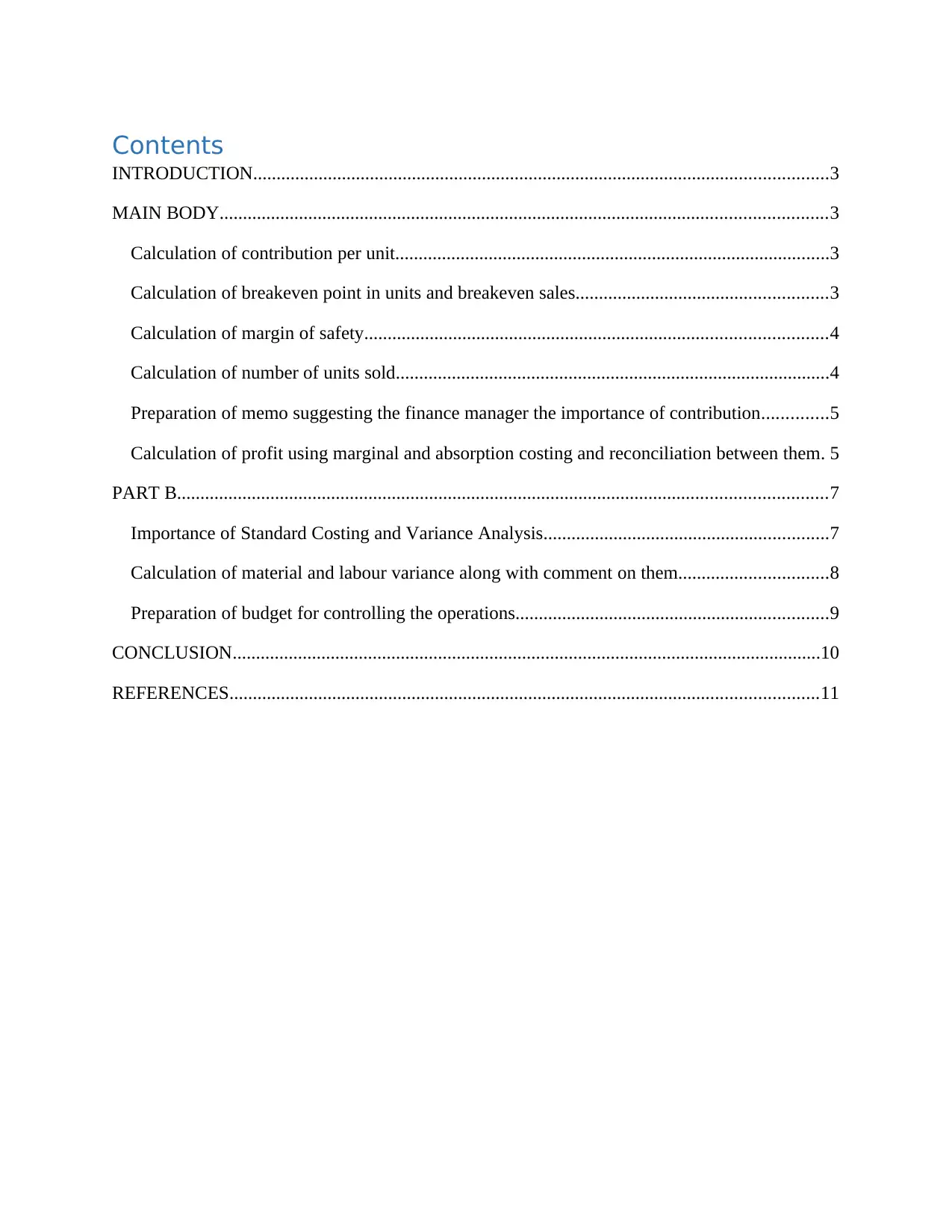
Contents
INTRODUCTION...........................................................................................................................3
MAIN BODY..................................................................................................................................3
Calculation of contribution per unit.............................................................................................3
Calculation of breakeven point in units and breakeven sales......................................................3
Calculation of margin of safety...................................................................................................4
Calculation of number of units sold.............................................................................................4
Preparation of memo suggesting the finance manager the importance of contribution..............5
Calculation of profit using marginal and absorption costing and reconciliation between them. 5
PART B...........................................................................................................................................7
Importance of Standard Costing and Variance Analysis.............................................................7
Calculation of material and labour variance along with comment on them................................8
Preparation of budget for controlling the operations...................................................................9
CONCLUSION..............................................................................................................................10
REFERENCES..............................................................................................................................11
INTRODUCTION...........................................................................................................................3
MAIN BODY..................................................................................................................................3
Calculation of contribution per unit.............................................................................................3
Calculation of breakeven point in units and breakeven sales......................................................3
Calculation of margin of safety...................................................................................................4
Calculation of number of units sold.............................................................................................4
Preparation of memo suggesting the finance manager the importance of contribution..............5
Calculation of profit using marginal and absorption costing and reconciliation between them. 5
PART B...........................................................................................................................................7
Importance of Standard Costing and Variance Analysis.............................................................7
Calculation of material and labour variance along with comment on them................................8
Preparation of budget for controlling the operations...................................................................9
CONCLUSION..............................................................................................................................10
REFERENCES..............................................................................................................................11
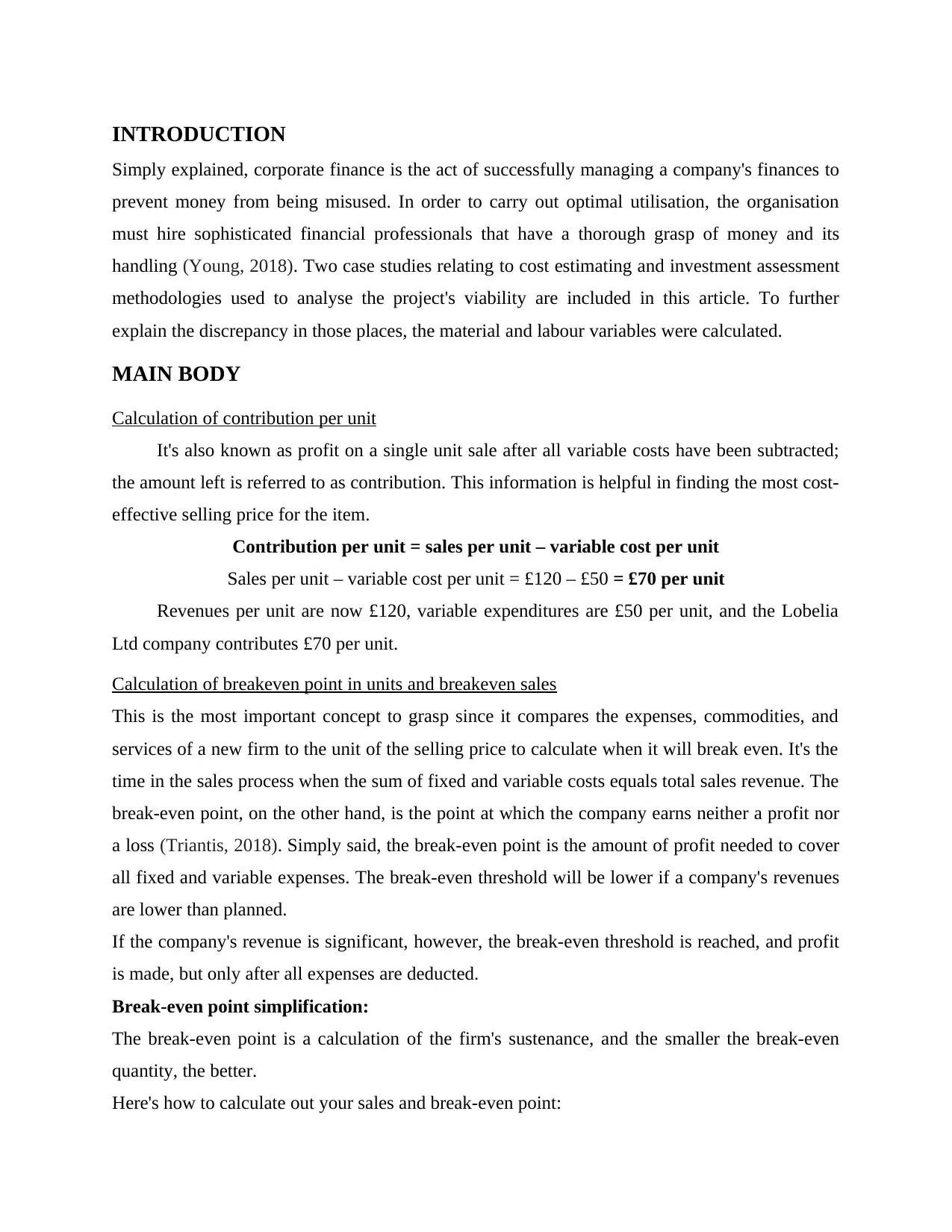
INTRODUCTION
Simply explained, corporate finance is the act of successfully managing a company's finances to
prevent money from being misused. In order to carry out optimal utilisation, the organisation
must hire sophisticated financial professionals that have a thorough grasp of money and its
handling (Young, 2018). Two case studies relating to cost estimating and investment assessment
methodologies used to analyse the project's viability are included in this article. To further
explain the discrepancy in those places, the material and labour variables were calculated.
MAIN BODY
Calculation of contribution per unit
It's also known as profit on a single unit sale after all variable costs have been subtracted;
the amount left is referred to as contribution. This information is helpful in finding the most cost-
effective selling price for the item.
Contribution per unit = sales per unit – variable cost per unit
Sales per unit – variable cost per unit = £120 – £50 = £70 per unit
Revenues per unit are now £120, variable expenditures are £50 per unit, and the Lobelia
Ltd company contributes £70 per unit.
Calculation of breakeven point in units and breakeven sales
This is the most important concept to grasp since it compares the expenses, commodities, and
services of a new firm to the unit of the selling price to calculate when it will break even. It's the
time in the sales process when the sum of fixed and variable costs equals total sales revenue. The
break-even point, on the other hand, is the point at which the company earns neither a profit nor
a loss (Triantis, 2018). Simply said, the break-even point is the amount of profit needed to cover
all fixed and variable expenses. The break-even threshold will be lower if a company's revenues
are lower than planned.
If the company's revenue is significant, however, the break-even threshold is reached, and profit
is made, but only after all expenses are deducted.
Break-even point simplification:
The break-even point is a calculation of the firm's sustenance, and the smaller the break-even
quantity, the better.
Here's how to calculate out your sales and break-even point:
Simply explained, corporate finance is the act of successfully managing a company's finances to
prevent money from being misused. In order to carry out optimal utilisation, the organisation
must hire sophisticated financial professionals that have a thorough grasp of money and its
handling (Young, 2018). Two case studies relating to cost estimating and investment assessment
methodologies used to analyse the project's viability are included in this article. To further
explain the discrepancy in those places, the material and labour variables were calculated.
MAIN BODY
Calculation of contribution per unit
It's also known as profit on a single unit sale after all variable costs have been subtracted;
the amount left is referred to as contribution. This information is helpful in finding the most cost-
effective selling price for the item.
Contribution per unit = sales per unit – variable cost per unit
Sales per unit – variable cost per unit = £120 – £50 = £70 per unit
Revenues per unit are now £120, variable expenditures are £50 per unit, and the Lobelia
Ltd company contributes £70 per unit.
Calculation of breakeven point in units and breakeven sales
This is the most important concept to grasp since it compares the expenses, commodities, and
services of a new firm to the unit of the selling price to calculate when it will break even. It's the
time in the sales process when the sum of fixed and variable costs equals total sales revenue. The
break-even point, on the other hand, is the point at which the company earns neither a profit nor
a loss (Triantis, 2018). Simply said, the break-even point is the amount of profit needed to cover
all fixed and variable expenses. The break-even threshold will be lower if a company's revenues
are lower than planned.
If the company's revenue is significant, however, the break-even threshold is reached, and profit
is made, but only after all expenses are deducted.
Break-even point simplification:
The break-even point is a calculation of the firm's sustenance, and the smaller the break-even
quantity, the better.
Here's how to calculate out your sales and break-even point:
⊘ This is a preview!⊘
Do you want full access?
Subscribe today to unlock all pages.

Trusted by 1+ million students worldwide
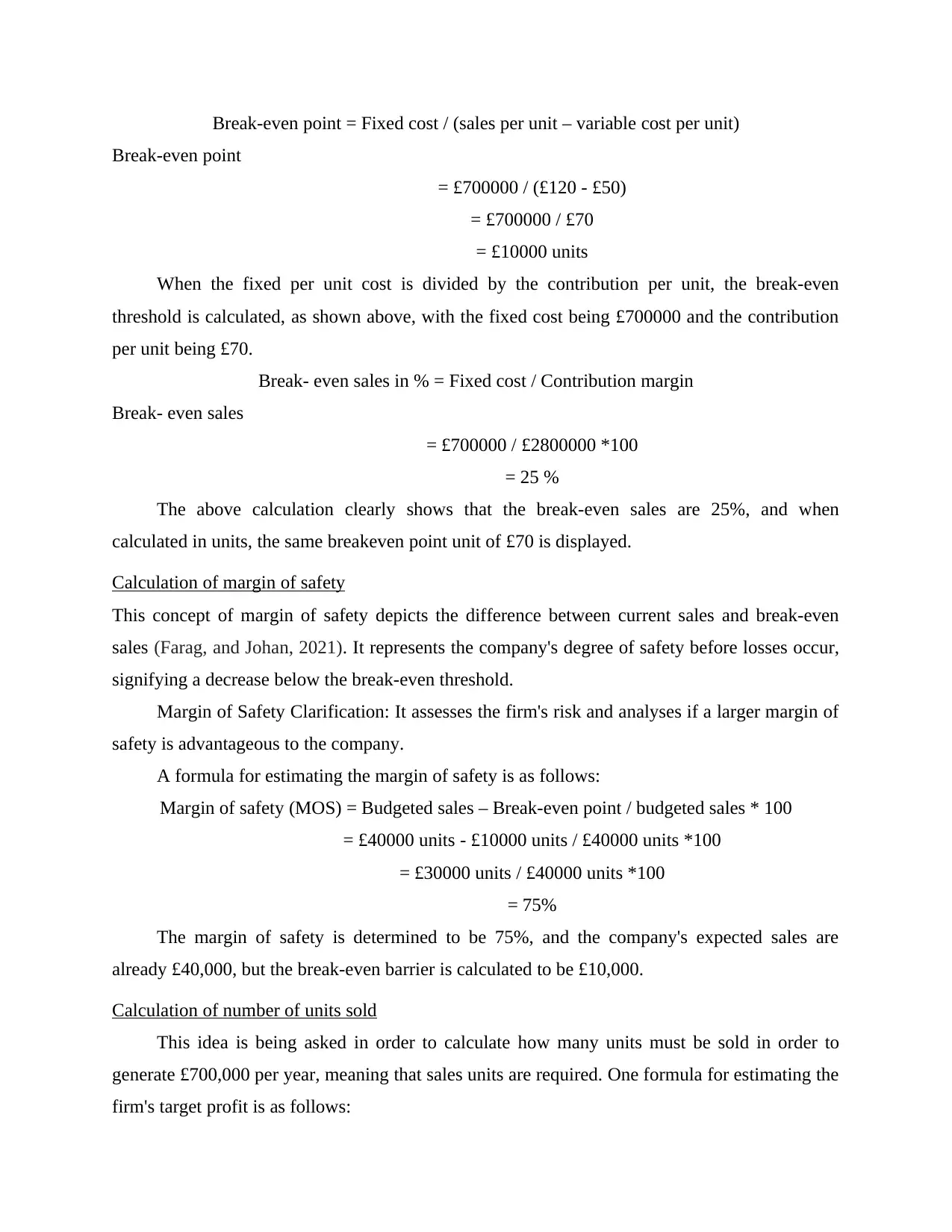
Break-even point = Fixed cost / (sales per unit – variable cost per unit)
Break-even point
= £700000 / (£120 - £50)
= £700000 / £70
= £10000 units
When the fixed per unit cost is divided by the contribution per unit, the break-even
threshold is calculated, as shown above, with the fixed cost being £700000 and the contribution
per unit being £70.
Break- even sales in % = Fixed cost / Contribution margin
Break- even sales
= £700000 / £2800000 *100
= 25 %
The above calculation clearly shows that the break-even sales are 25%, and when
calculated in units, the same breakeven point unit of £70 is displayed.
Calculation of margin of safety
This concept of margin of safety depicts the difference between current sales and break-even
sales (Farag, and Johan, 2021). It represents the company's degree of safety before losses occur,
signifying a decrease below the break-even threshold.
Margin of Safety Clarification: It assesses the firm's risk and analyses if a larger margin of
safety is advantageous to the company.
A formula for estimating the margin of safety is as follows:
Margin of safety (MOS) = Budgeted sales – Break-even point / budgeted sales * 100
= £40000 units - £10000 units / £40000 units *100
= £30000 units / £40000 units *100
= 75%
The margin of safety is determined to be 75%, and the company's expected sales are
already £40,000, but the break-even barrier is calculated to be £10,000.
Calculation of number of units sold
This idea is being asked in order to calculate how many units must be sold in order to
generate £700,000 per year, meaning that sales units are required. One formula for estimating the
firm's target profit is as follows:
Break-even point
= £700000 / (£120 - £50)
= £700000 / £70
= £10000 units
When the fixed per unit cost is divided by the contribution per unit, the break-even
threshold is calculated, as shown above, with the fixed cost being £700000 and the contribution
per unit being £70.
Break- even sales in % = Fixed cost / Contribution margin
Break- even sales
= £700000 / £2800000 *100
= 25 %
The above calculation clearly shows that the break-even sales are 25%, and when
calculated in units, the same breakeven point unit of £70 is displayed.
Calculation of margin of safety
This concept of margin of safety depicts the difference between current sales and break-even
sales (Farag, and Johan, 2021). It represents the company's degree of safety before losses occur,
signifying a decrease below the break-even threshold.
Margin of Safety Clarification: It assesses the firm's risk and analyses if a larger margin of
safety is advantageous to the company.
A formula for estimating the margin of safety is as follows:
Margin of safety (MOS) = Budgeted sales – Break-even point / budgeted sales * 100
= £40000 units - £10000 units / £40000 units *100
= £30000 units / £40000 units *100
= 75%
The margin of safety is determined to be 75%, and the company's expected sales are
already £40,000, but the break-even barrier is calculated to be £10,000.
Calculation of number of units sold
This idea is being asked in order to calculate how many units must be sold in order to
generate £700,000 per year, meaning that sales units are required. One formula for estimating the
firm's target profit is as follows:
Paraphrase This Document
Need a fresh take? Get an instant paraphrase of this document with our AI Paraphraser
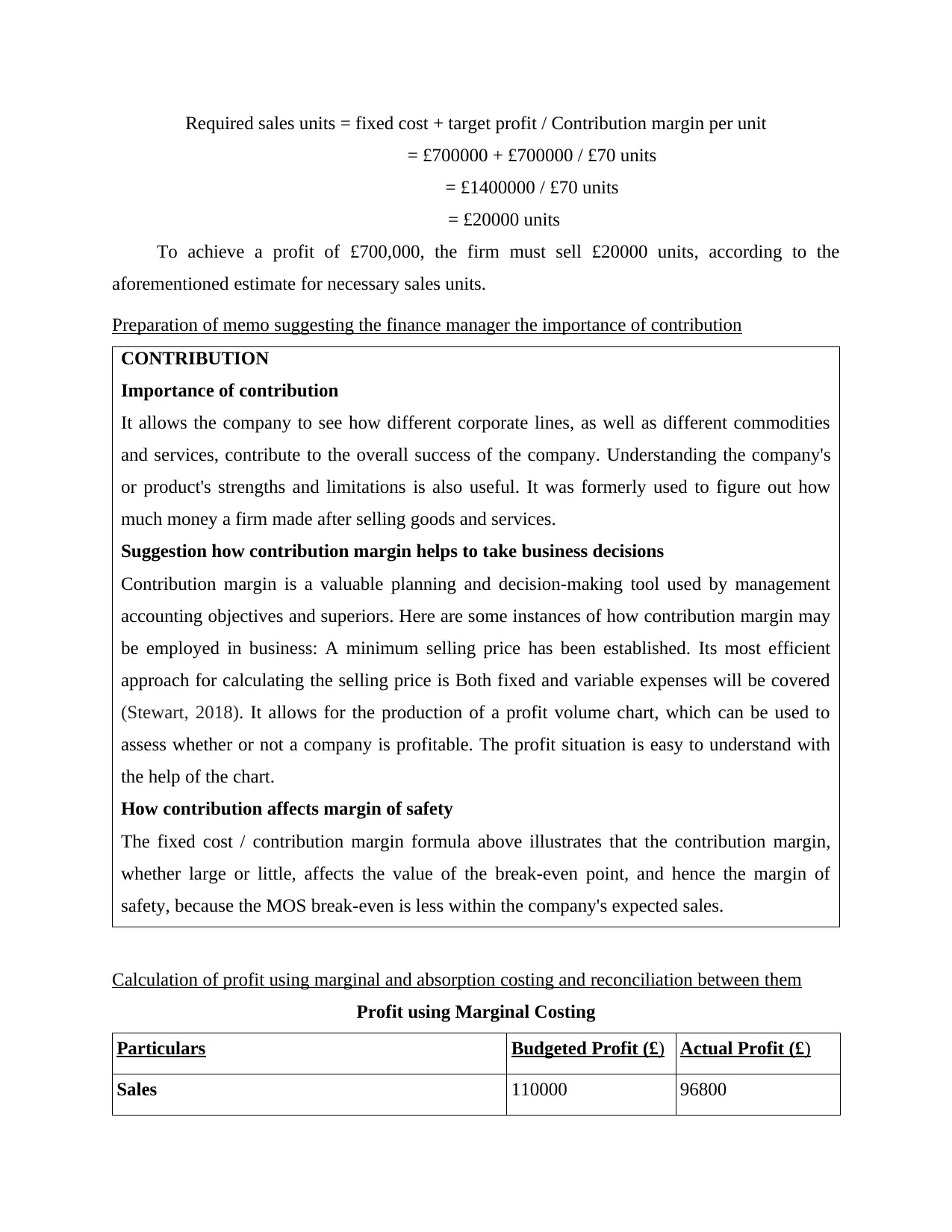
Required sales units = fixed cost + target profit / Contribution margin per unit
= £700000 + £700000 / £70 units
= £1400000 / £70 units
= £20000 units
To achieve a profit of £700,000, the firm must sell £20000 units, according to the
aforementioned estimate for necessary sales units.
Preparation of memo suggesting the finance manager the importance of contribution
CONTRIBUTION
Importance of contribution
It allows the company to see how different corporate lines, as well as different commodities
and services, contribute to the overall success of the company. Understanding the company's
or product's strengths and limitations is also useful. It was formerly used to figure out how
much money a firm made after selling goods and services.
Suggestion how contribution margin helps to take business decisions
Contribution margin is a valuable planning and decision-making tool used by management
accounting objectives and superiors. Here are some instances of how contribution margin may
be employed in business: A minimum selling price has been established. Its most efficient
approach for calculating the selling price is Both fixed and variable expenses will be covered
(Stewart, 2018). It allows for the production of a profit volume chart, which can be used to
assess whether or not a company is profitable. The profit situation is easy to understand with
the help of the chart.
How contribution affects margin of safety
The fixed cost / contribution margin formula above illustrates that the contribution margin,
whether large or little, affects the value of the break-even point, and hence the margin of
safety, because the MOS break-even is less within the company's expected sales.
Calculation of profit using marginal and absorption costing and reconciliation between them
Profit using Marginal Costing
Particulars Budgeted Profit (£) Actual Profit (£)
Sales 110000 96800
= £700000 + £700000 / £70 units
= £1400000 / £70 units
= £20000 units
To achieve a profit of £700,000, the firm must sell £20000 units, according to the
aforementioned estimate for necessary sales units.
Preparation of memo suggesting the finance manager the importance of contribution
CONTRIBUTION
Importance of contribution
It allows the company to see how different corporate lines, as well as different commodities
and services, contribute to the overall success of the company. Understanding the company's
or product's strengths and limitations is also useful. It was formerly used to figure out how
much money a firm made after selling goods and services.
Suggestion how contribution margin helps to take business decisions
Contribution margin is a valuable planning and decision-making tool used by management
accounting objectives and superiors. Here are some instances of how contribution margin may
be employed in business: A minimum selling price has been established. Its most efficient
approach for calculating the selling price is Both fixed and variable expenses will be covered
(Stewart, 2018). It allows for the production of a profit volume chart, which can be used to
assess whether or not a company is profitable. The profit situation is easy to understand with
the help of the chart.
How contribution affects margin of safety
The fixed cost / contribution margin formula above illustrates that the contribution margin,
whether large or little, affects the value of the break-even point, and hence the margin of
safety, because the MOS break-even is less within the company's expected sales.
Calculation of profit using marginal and absorption costing and reconciliation between them
Profit using Marginal Costing
Particulars Budgeted Profit (£) Actual Profit (£)
Sales 110000 96800
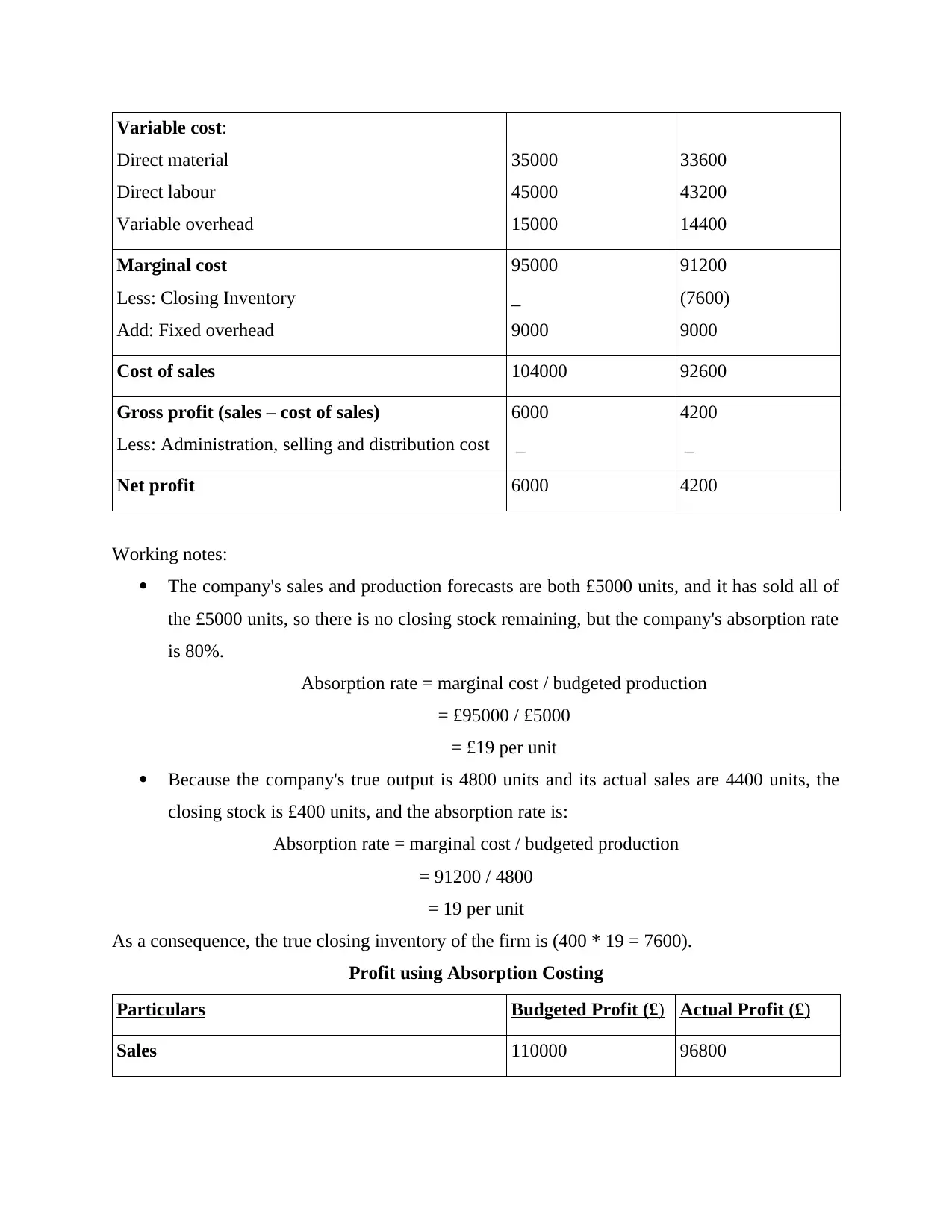
Variable cost:
Direct material
Direct labour
Variable overhead
35000
45000
15000
33600
43200
14400
Marginal cost
Less: Closing Inventory
Add: Fixed overhead
95000
_
9000
91200
(7600)
9000
Cost of sales 104000 92600
Gross profit (sales – cost of sales)
Less: Administration, selling and distribution cost
6000
_
4200
_
Net profit 6000 4200
Working notes:
The company's sales and production forecasts are both £5000 units, and it has sold all of
the £5000 units, so there is no closing stock remaining, but the company's absorption rate
is 80%.
Absorption rate = marginal cost / budgeted production
= £95000 / £5000
= £19 per unit
Because the company's true output is 4800 units and its actual sales are 4400 units, the
closing stock is £400 units, and the absorption rate is:
Absorption rate = marginal cost / budgeted production
= 91200 / 4800
= 19 per unit
As a consequence, the true closing inventory of the firm is (400 * 19 = 7600).
Profit using Absorption Costing
Particulars Budgeted Profit (£) Actual Profit (£)
Sales 110000 96800
Direct material
Direct labour
Variable overhead
35000
45000
15000
33600
43200
14400
Marginal cost
Less: Closing Inventory
Add: Fixed overhead
95000
_
9000
91200
(7600)
9000
Cost of sales 104000 92600
Gross profit (sales – cost of sales)
Less: Administration, selling and distribution cost
6000
_
4200
_
Net profit 6000 4200
Working notes:
The company's sales and production forecasts are both £5000 units, and it has sold all of
the £5000 units, so there is no closing stock remaining, but the company's absorption rate
is 80%.
Absorption rate = marginal cost / budgeted production
= £95000 / £5000
= £19 per unit
Because the company's true output is 4800 units and its actual sales are 4400 units, the
closing stock is £400 units, and the absorption rate is:
Absorption rate = marginal cost / budgeted production
= 91200 / 4800
= 19 per unit
As a consequence, the true closing inventory of the firm is (400 * 19 = 7600).
Profit using Absorption Costing
Particulars Budgeted Profit (£) Actual Profit (£)
Sales 110000 96800
⊘ This is a preview!⊘
Do you want full access?
Subscribe today to unlock all pages.

Trusted by 1+ million students worldwide
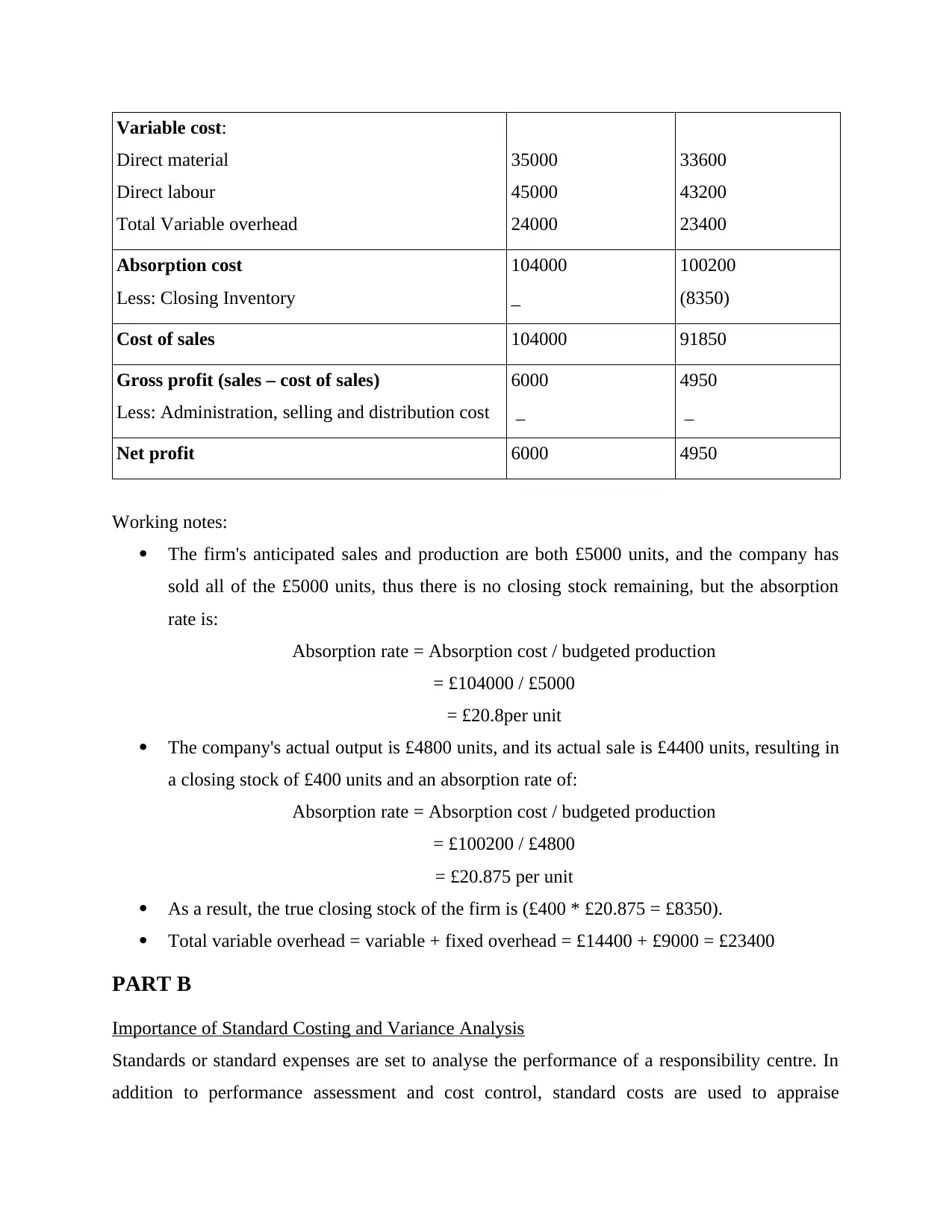
Variable cost:
Direct material
Direct labour
Total Variable overhead
35000
45000
24000
33600
43200
23400
Absorption cost
Less: Closing Inventory
104000
_
100200
(8350)
Cost of sales 104000 91850
Gross profit (sales – cost of sales)
Less: Administration, selling and distribution cost
6000
_
4950
_
Net profit 6000 4950
Working notes:
The firm's anticipated sales and production are both £5000 units, and the company has
sold all of the £5000 units, thus there is no closing stock remaining, but the absorption
rate is:
Absorption rate = Absorption cost / budgeted production
= £104000 / £5000
= £20.8per unit
The company's actual output is £4800 units, and its actual sale is £4400 units, resulting in
a closing stock of £400 units and an absorption rate of:
Absorption rate = Absorption cost / budgeted production
= £100200 / £4800
= £20.875 per unit
As a result, the true closing stock of the firm is (£400 * £20.875 = £8350).
Total variable overhead = variable + fixed overhead = £14400 + £9000 = £23400
PART B
Importance of Standard Costing and Variance Analysis
Standards or standard expenses are set to analyse the performance of a responsibility centre. In
addition to performance assessment and cost control, standard costs are used to appraise
Direct material
Direct labour
Total Variable overhead
35000
45000
24000
33600
43200
23400
Absorption cost
Less: Closing Inventory
104000
_
100200
(8350)
Cost of sales 104000 91850
Gross profit (sales – cost of sales)
Less: Administration, selling and distribution cost
6000
_
4950
_
Net profit 6000 4950
Working notes:
The firm's anticipated sales and production are both £5000 units, and the company has
sold all of the £5000 units, thus there is no closing stock remaining, but the absorption
rate is:
Absorption rate = Absorption cost / budgeted production
= £104000 / £5000
= £20.8per unit
The company's actual output is £4800 units, and its actual sale is £4400 units, resulting in
a closing stock of £400 units and an absorption rate of:
Absorption rate = Absorption cost / budgeted production
= £100200 / £4800
= £20.875 per unit
As a result, the true closing stock of the firm is (£400 * £20.875 = £8350).
Total variable overhead = variable + fixed overhead = £14400 + £9000 = £23400
PART B
Importance of Standard Costing and Variance Analysis
Standards or standard expenses are set to analyse the performance of a responsibility centre. In
addition to performance assessment and cost control, standard costs are used to appraise
Paraphrase This Document
Need a fresh take? Get an instant paraphrase of this document with our AI Paraphraser
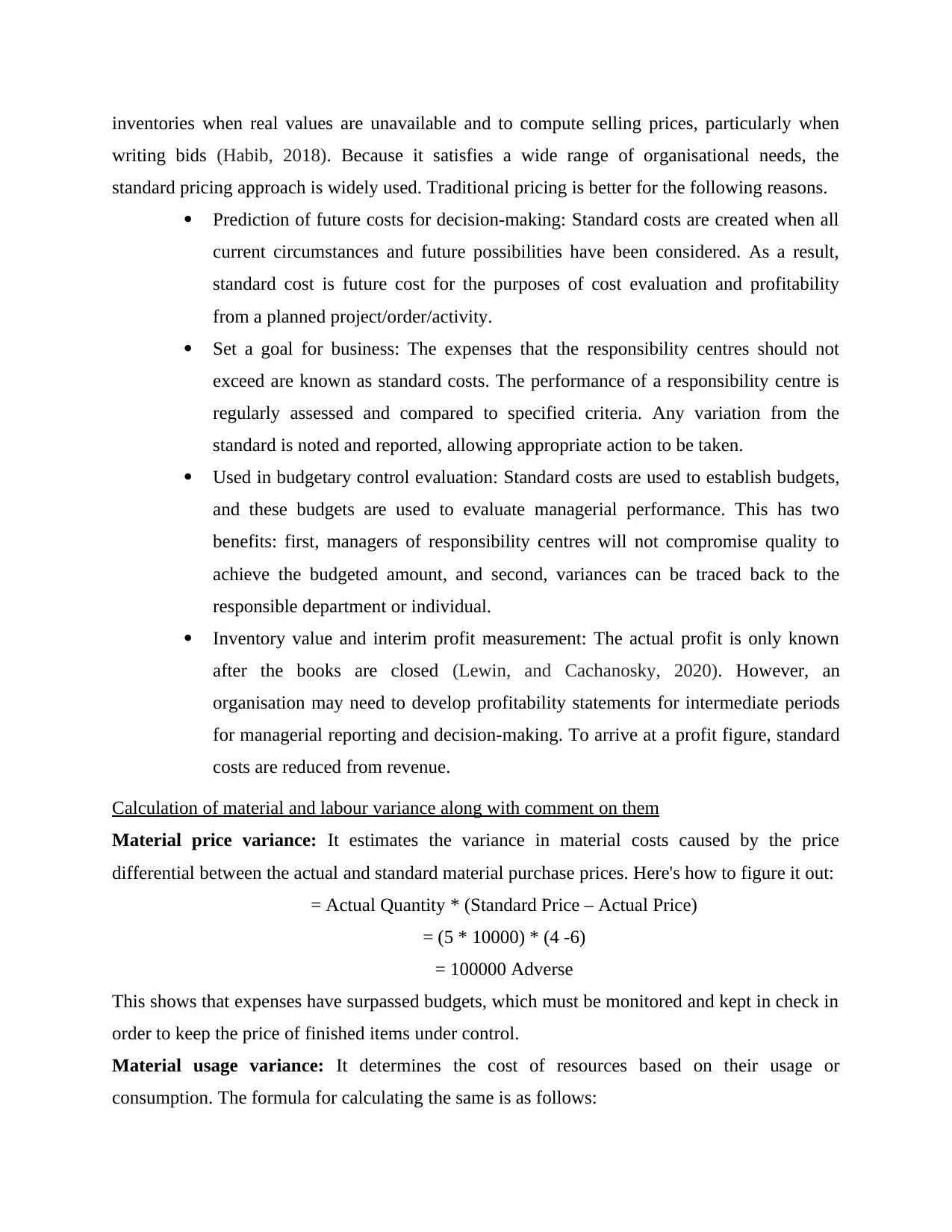
inventories when real values are unavailable and to compute selling prices, particularly when
writing bids (Habib, 2018). Because it satisfies a wide range of organisational needs, the
standard pricing approach is widely used. Traditional pricing is better for the following reasons.
Prediction of future costs for decision-making: Standard costs are created when all
current circumstances and future possibilities have been considered. As a result,
standard cost is future cost for the purposes of cost evaluation and profitability
from a planned project/order/activity.
Set a goal for business: The expenses that the responsibility centres should not
exceed are known as standard costs. The performance of a responsibility centre is
regularly assessed and compared to specified criteria. Any variation from the
standard is noted and reported, allowing appropriate action to be taken.
Used in budgetary control evaluation: Standard costs are used to establish budgets,
and these budgets are used to evaluate managerial performance. This has two
benefits: first, managers of responsibility centres will not compromise quality to
achieve the budgeted amount, and second, variances can be traced back to the
responsible department or individual.
Inventory value and interim profit measurement: The actual profit is only known
after the books are closed (Lewin, and Cachanosky, 2020). However, an
organisation may need to develop profitability statements for intermediate periods
for managerial reporting and decision-making. To arrive at a profit figure, standard
costs are reduced from revenue.
Calculation of material and labour variance along with comment on them
Material price variance: It estimates the variance in material costs caused by the price
differential between the actual and standard material purchase prices. Here's how to figure it out:
= Actual Quantity * (Standard Price – Actual Price)
= (5 * 10000) * (4 -6)
= 100000 Adverse
This shows that expenses have surpassed budgets, which must be monitored and kept in check in
order to keep the price of finished items under control.
Material usage variance: It determines the cost of resources based on their usage or
consumption. The formula for calculating the same is as follows:
writing bids (Habib, 2018). Because it satisfies a wide range of organisational needs, the
standard pricing approach is widely used. Traditional pricing is better for the following reasons.
Prediction of future costs for decision-making: Standard costs are created when all
current circumstances and future possibilities have been considered. As a result,
standard cost is future cost for the purposes of cost evaluation and profitability
from a planned project/order/activity.
Set a goal for business: The expenses that the responsibility centres should not
exceed are known as standard costs. The performance of a responsibility centre is
regularly assessed and compared to specified criteria. Any variation from the
standard is noted and reported, allowing appropriate action to be taken.
Used in budgetary control evaluation: Standard costs are used to establish budgets,
and these budgets are used to evaluate managerial performance. This has two
benefits: first, managers of responsibility centres will not compromise quality to
achieve the budgeted amount, and second, variances can be traced back to the
responsible department or individual.
Inventory value and interim profit measurement: The actual profit is only known
after the books are closed (Lewin, and Cachanosky, 2020). However, an
organisation may need to develop profitability statements for intermediate periods
for managerial reporting and decision-making. To arrive at a profit figure, standard
costs are reduced from revenue.
Calculation of material and labour variance along with comment on them
Material price variance: It estimates the variance in material costs caused by the price
differential between the actual and standard material purchase prices. Here's how to figure it out:
= Actual Quantity * (Standard Price – Actual Price)
= (5 * 10000) * (4 -6)
= 100000 Adverse
This shows that expenses have surpassed budgets, which must be monitored and kept in check in
order to keep the price of finished items under control.
Material usage variance: It determines the cost of resources based on their usage or
consumption. The formula for calculating the same is as follows:
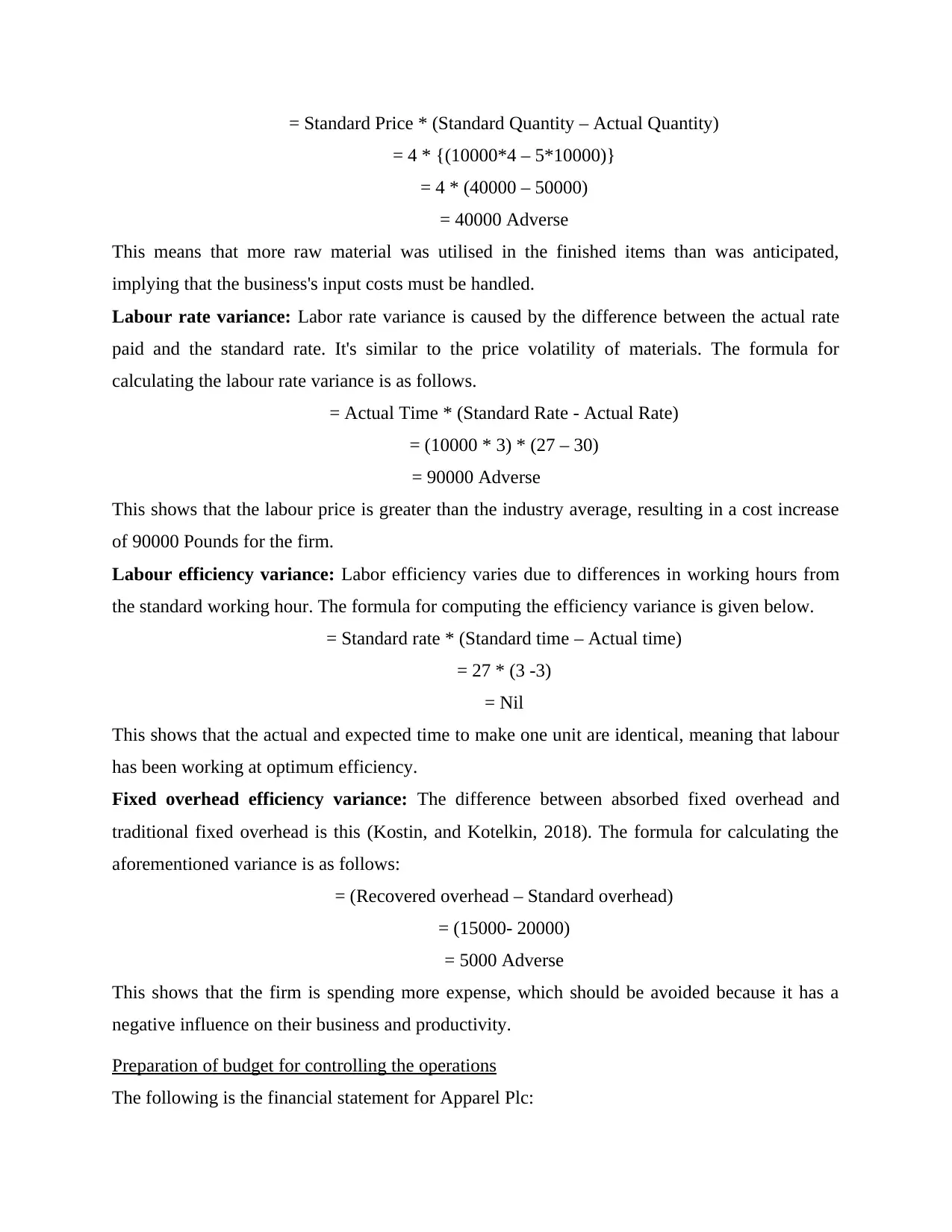
= Standard Price * (Standard Quantity – Actual Quantity)
= 4 * {(10000*4 – 5*10000)}
= 4 * (40000 – 50000)
= 40000 Adverse
This means that more raw material was utilised in the finished items than was anticipated,
implying that the business's input costs must be handled.
Labour rate variance: Labor rate variance is caused by the difference between the actual rate
paid and the standard rate. It's similar to the price volatility of materials. The formula for
calculating the labour rate variance is as follows.
= Actual Time * (Standard Rate - Actual Rate)
= (10000 * 3) * (27 – 30)
= 90000 Adverse
This shows that the labour price is greater than the industry average, resulting in a cost increase
of 90000 Pounds for the firm.
Labour efficiency variance: Labor efficiency varies due to differences in working hours from
the standard working hour. The formula for computing the efficiency variance is given below.
= Standard rate * (Standard time – Actual time)
= 27 * (3 -3)
= Nil
This shows that the actual and expected time to make one unit are identical, meaning that labour
has been working at optimum efficiency.
Fixed overhead efficiency variance: The difference between absorbed fixed overhead and
traditional fixed overhead is this (Kostin, and Kotelkin, 2018). The formula for calculating the
aforementioned variance is as follows:
= (Recovered overhead – Standard overhead)
= (15000- 20000)
= 5000 Adverse
This shows that the firm is spending more expense, which should be avoided because it has a
negative influence on their business and productivity.
Preparation of budget for controlling the operations
The following is the financial statement for Apparel Plc:
= 4 * {(10000*4 – 5*10000)}
= 4 * (40000 – 50000)
= 40000 Adverse
This means that more raw material was utilised in the finished items than was anticipated,
implying that the business's input costs must be handled.
Labour rate variance: Labor rate variance is caused by the difference between the actual rate
paid and the standard rate. It's similar to the price volatility of materials. The formula for
calculating the labour rate variance is as follows.
= Actual Time * (Standard Rate - Actual Rate)
= (10000 * 3) * (27 – 30)
= 90000 Adverse
This shows that the labour price is greater than the industry average, resulting in a cost increase
of 90000 Pounds for the firm.
Labour efficiency variance: Labor efficiency varies due to differences in working hours from
the standard working hour. The formula for computing the efficiency variance is given below.
= Standard rate * (Standard time – Actual time)
= 27 * (3 -3)
= Nil
This shows that the actual and expected time to make one unit are identical, meaning that labour
has been working at optimum efficiency.
Fixed overhead efficiency variance: The difference between absorbed fixed overhead and
traditional fixed overhead is this (Kostin, and Kotelkin, 2018). The formula for calculating the
aforementioned variance is as follows:
= (Recovered overhead – Standard overhead)
= (15000- 20000)
= 5000 Adverse
This shows that the firm is spending more expense, which should be avoided because it has a
negative influence on their business and productivity.
Preparation of budget for controlling the operations
The following is the financial statement for Apparel Plc:
⊘ This is a preview!⊘
Do you want full access?
Subscribe today to unlock all pages.

Trusted by 1+ million students worldwide
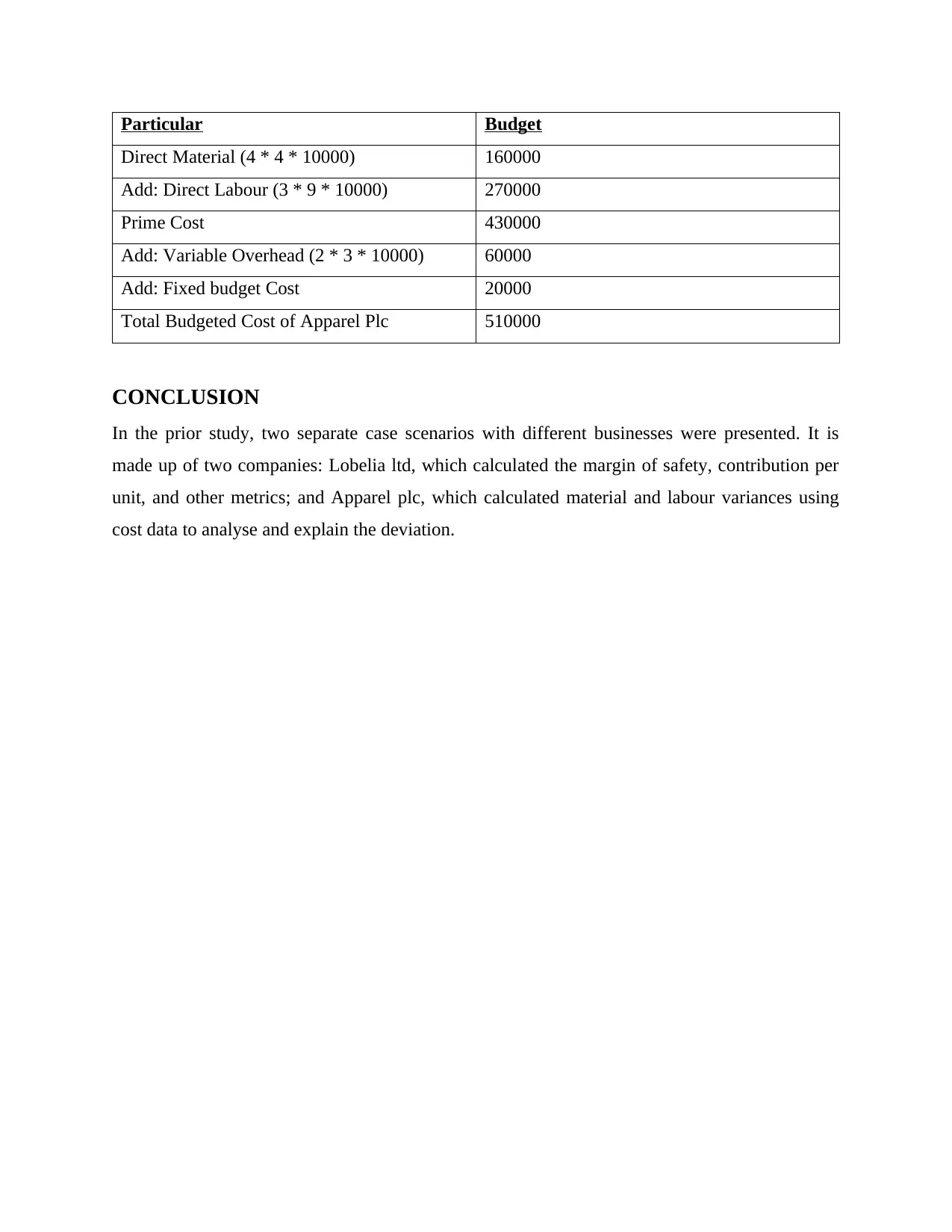
Particular Budget
Direct Material (4 * 4 * 10000) 160000
Add: Direct Labour (3 * 9 * 10000) 270000
Prime Cost 430000
Add: Variable Overhead (2 * 3 * 10000) 60000
Add: Fixed budget Cost 20000
Total Budgeted Cost of Apparel Plc 510000
CONCLUSION
In the prior study, two separate case scenarios with different businesses were presented. It is
made up of two companies: Lobelia ltd, which calculated the margin of safety, contribution per
unit, and other metrics; and Apparel plc, which calculated material and labour variances using
cost data to analyse and explain the deviation.
Direct Material (4 * 4 * 10000) 160000
Add: Direct Labour (3 * 9 * 10000) 270000
Prime Cost 430000
Add: Variable Overhead (2 * 3 * 10000) 60000
Add: Fixed budget Cost 20000
Total Budgeted Cost of Apparel Plc 510000
CONCLUSION
In the prior study, two separate case scenarios with different businesses were presented. It is
made up of two companies: Lobelia ltd, which calculated the margin of safety, contribution per
unit, and other metrics; and Apparel plc, which calculated material and labour variances using
cost data to analyse and explain the deviation.
Paraphrase This Document
Need a fresh take? Get an instant paraphrase of this document with our AI Paraphraser
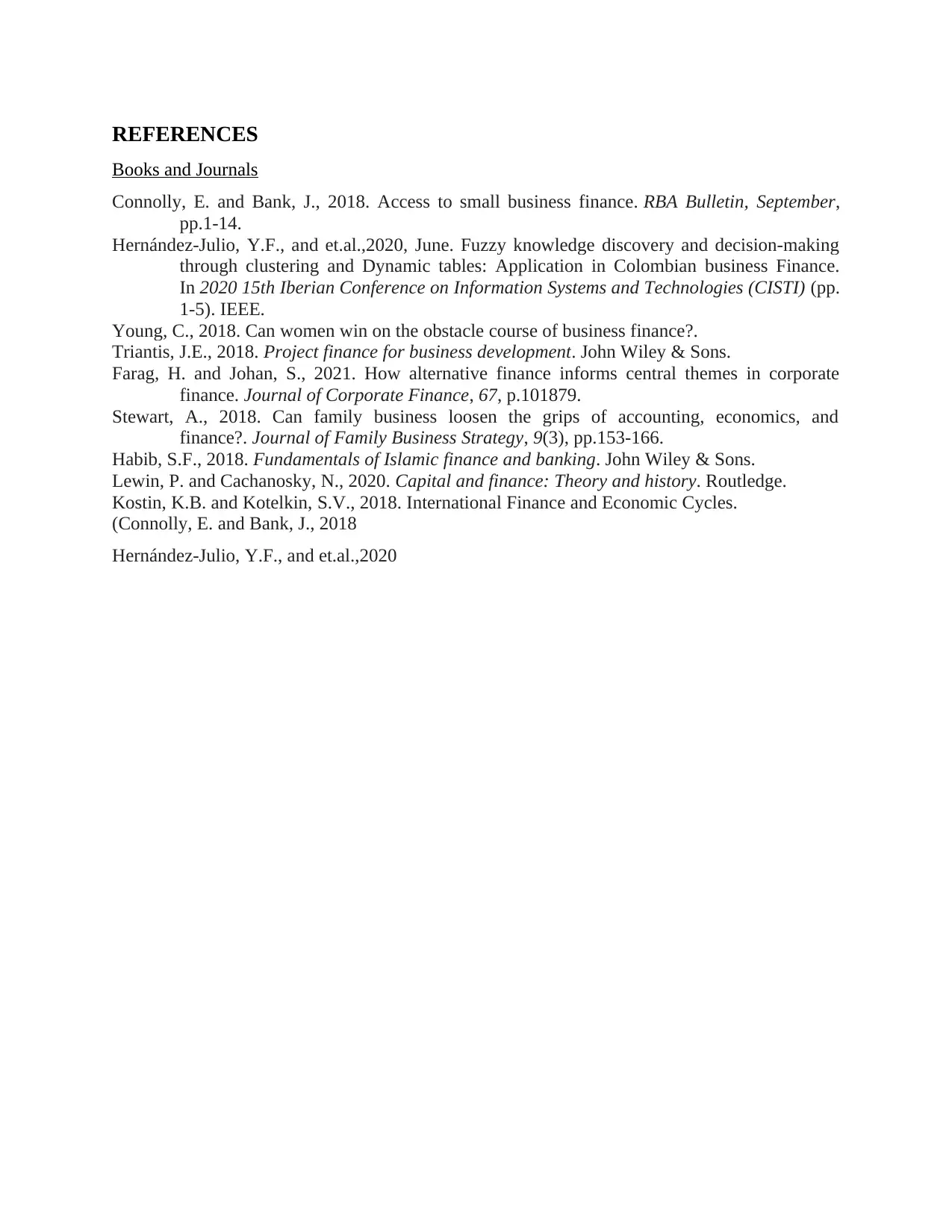
REFERENCES
Books and Journals
Connolly, E. and Bank, J., 2018. Access to small business finance. RBA Bulletin, September,
pp.1-14.
Hernández-Julio, Y.F., and et.al.,2020, June. Fuzzy knowledge discovery and decision-making
through clustering and Dynamic tables: Application in Colombian business Finance.
In 2020 15th Iberian Conference on Information Systems and Technologies (CISTI) (pp.
1-5). IEEE.
Young, C., 2018. Can women win on the obstacle course of business finance?.
Triantis, J.E., 2018. Project finance for business development. John Wiley & Sons.
Farag, H. and Johan, S., 2021. How alternative finance informs central themes in corporate
finance. Journal of Corporate Finance, 67, p.101879.
Stewart, A., 2018. Can family business loosen the grips of accounting, economics, and
finance?. Journal of Family Business Strategy, 9(3), pp.153-166.
Habib, S.F., 2018. Fundamentals of Islamic finance and banking. John Wiley & Sons.
Lewin, P. and Cachanosky, N., 2020. Capital and finance: Theory and history. Routledge.
Kostin, K.B. and Kotelkin, S.V., 2018. International Finance and Economic Cycles.
(Connolly, E. and Bank, J., 2018
Hernández-Julio, Y.F., and et.al.,2020
Books and Journals
Connolly, E. and Bank, J., 2018. Access to small business finance. RBA Bulletin, September,
pp.1-14.
Hernández-Julio, Y.F., and et.al.,2020, June. Fuzzy knowledge discovery and decision-making
through clustering and Dynamic tables: Application in Colombian business Finance.
In 2020 15th Iberian Conference on Information Systems and Technologies (CISTI) (pp.
1-5). IEEE.
Young, C., 2018. Can women win on the obstacle course of business finance?.
Triantis, J.E., 2018. Project finance for business development. John Wiley & Sons.
Farag, H. and Johan, S., 2021. How alternative finance informs central themes in corporate
finance. Journal of Corporate Finance, 67, p.101879.
Stewart, A., 2018. Can family business loosen the grips of accounting, economics, and
finance?. Journal of Family Business Strategy, 9(3), pp.153-166.
Habib, S.F., 2018. Fundamentals of Islamic finance and banking. John Wiley & Sons.
Lewin, P. and Cachanosky, N., 2020. Capital and finance: Theory and history. Routledge.
Kostin, K.B. and Kotelkin, S.V., 2018. International Finance and Economic Cycles.
(Connolly, E. and Bank, J., 2018
Hernández-Julio, Y.F., and et.al.,2020
1 out of 11
Related Documents
Your All-in-One AI-Powered Toolkit for Academic Success.
+13062052269
info@desklib.com
Available 24*7 on WhatsApp / Email
![[object Object]](/_next/static/media/star-bottom.7253800d.svg)
Unlock your academic potential
Copyright © 2020–2025 A2Z Services. All Rights Reserved. Developed and managed by ZUCOL.





